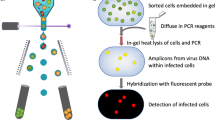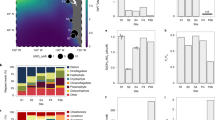Abstract
NATURAL marine waters contain roughly 106 to 109 virus particles per ml, yet their role in aquatic ecosystems and the organisms that they infect remain largely unknown. Electron microscopy has been used to study interactions between viruses and their hosts, focusing mainly on pathogens to prokaryotic organisms1–5. Here we demonstrate that viral pathogens infect a variety of important marine primary producers, including diatoms, cryptophytes, prasinophytes and chroococcoid cyanobacteria. Also, addition to sea water of particles in the 0.002–0.2 μm size range, concentrated from sea water by ultrafiltration, reduced primary productivity ([14C]bicarbonate incorporation) by as much as 78%. These results indicate that, in addition to grazing and nutrient limitation, infection by viruses could be a factor regulating phytoplankton community structure and primary productivity in the oceans.
This is a preview of subscription content, access via your institution
Access options
Subscribe to this journal
Receive 51 print issues and online access
$199.00 per year
only $3.90 per issue
Buy this article
- Purchase on Springer Link
- Instant access to full article PDF
Prices may be subject to local taxes which are calculated during checkout
Similar content being viewed by others
References
Sieburth, J. McN., Johnson, P. W. & Hargraves, P. E. J. Phycol. 18, 416–425 (1988).
Bergh, Ø., Børsheim, G., Bratbak, G. & Heldal, M. Nature 340, 467–468 (1989).
Proctor, L. M. & Fuhrman, J. A. Nature 343, 60–62 (1989).
Borsheim, K. Y., Bratbak, G., & Heldal, M. Appl. envir. Microbiool. 56, 352–356 (1990).
Bratbak, G., Heldal, M., Norland, S. & Thingstad, F. Appl. envir. Microbiol. 56, 1400–1405 (1990).
Miller, S. E. J. Electron Miscros. Tech. 4, 265–301 (1986).
Keller, M. D., Bellows, W. K. & Guillard, R. R. L. J. exp. mar. Biol. Ecol. 117, 279–283 (1987).
Mayer, J. A. & Taylor, F. J. R. Nature 281, 299–301 (1979).
Waters, R. E. & Chan, A. T. J. gen. Virol. 62, 199–206 (1982).
Meintz, R. H., Schuster, A. M. & Van Etten, J. L. Plant molec. Biol. Rep. 3, 180–187 (1985).
Van Etten, J. L., Xia, Y. & Meintz, R. H. in Plant-Microbe Interactions Vol. 2 (eds Kosuge, T. & Nester, E. W.) 307–325 (Macmillan, New York, 1987).
Van Etten, J. L., Burbank, D. E., Kuczmarski, D. & Meintz, R. H. Science 219, 994–996 (1983).
Shapiro, L. P. & Guillard, R. R. L. in Photosynthetic Picoplankton (eds Platt, T. & Li, W. K. W.) Can. Bull. Fish. aquat. Sci. 214, 371–389 (1986).
Thomsen, H. A. Can. Bull. Fish. aquat. Sci. 214, 121–158 (1986).
Gieskes, W. W. C. & Elbrachter, M. Neth. J. Sea Res. 20, 291–303 (1986).
Vargo, G. A. et al. Limnol. Oceanogr. 32, 762–767 (1987).
Sellner, K. G. & Brownlee, D. C. in Toxic Marine Phytoplankton (eds Graneli, E., Sundstrom, B., Edler, L. & Anderson, D. M.) 221–226 (Elsevier, New York, 1990).
Coleman, A. W., Maguire, M. J. & Coleman, J. R. J. Histochem. Cytochem. 29, 959–968 (1981).
Author information
Authors and Affiliations
Rights and permissions
About this article
Cite this article
Suttle, C., Chan, A. & Cottrell, M. Infection of phytoplankton by viruses and reduction of primary productivity. Nature 347, 467–469 (1990). https://doi.org/10.1038/347467a0
Received:
Accepted:
Issue Date:
DOI: https://doi.org/10.1038/347467a0
This article is cited by
-
Vitamin B12 is not shared by all marine prototrophic bacteria with their environment
The ISME Journal (2023)
-
Agricultural Land Use Influences Bacteriophage Community Diversity, Richness, and Heterogeneity
Current Microbiology (2023)
-
Toward phytoplankton parasite detection using autoencoders
Machine Vision and Applications (2023)
-
Virus, plankton and evolution
International Journal of Earth Sciences (2021)
-
Isolation and complete genome sequence of a novel cyanophage, S-B05, infecting an estuarine Synechococcus strain: insights into environmental adaptation
Archives of Virology (2020)
Comments
By submitting a comment you agree to abide by our Terms and Community Guidelines. If you find something abusive or that does not comply with our terms or guidelines please flag it as inappropriate.



